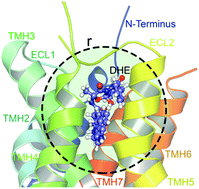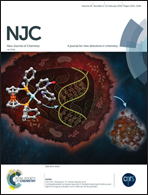Outlining migrainous through dihydroergotamine–serotonin receptor interactions using quantum biochemistry†
Abstract
Since the early days of migrainous research, serotonin receptors (5-HTR) have been considered a major target of drugs, and the 5-HT1B and 5-HT1D agonists have been among the most marketed ones for the treatment of migraine attacks. Besides, the 5-HT1BR agonist is also involved in the mechanisms underlying many neurological dysfunctions, making it a critical target for the rational development of drugs. In this context, by taking advantage of its first crystallographic structure co-crystallized with dihydroergotamine (DHE), one of the oldest and largely used antimigraine drugs, a quantum biochemistry study based on the electrostatically embedded molecular fractionation with conjugate caps (EE-MFCC) scheme within the density functional theory (DFT) formalism is performed to unveil this complex's detailed binding energy. In the EE-MFCC model, each fragment is embedded within the electrostatic effect of the full protein, in such a way that all atoms are replaced by their corresponding atomic charges, excluding the reference residues. Our results reveal not only the pivotal role played by the amino-acid residue D129 in the dihydroergotamine–5-HT1BR total binding energy, but also the importance of the residues D352, D123, E198, D204, F330, L126, F351, I130, V201, V200, T355 and R114 in this complex. The total binding energy reaches convergence after a pocket radius r = 7.0 Å, with a value around −230.93 kcal mol−1. Furthermore, we predict the relevance (energetically) of the DHE regions, as well as the influence of each protein segment to DHE–serotonin receptor binding. Finally, for completeness, we compared our results obtained by using the EE-MFCC approach with those considering the ordinary MFCC scheme. We believe that our work is a first step using in silico quantum biochemical design as a means to influence the discovery of new drugs to treat migraine and other diseases related to the 5-HT1BR agonist.



 Please wait while we load your content...
Please wait while we load your content...